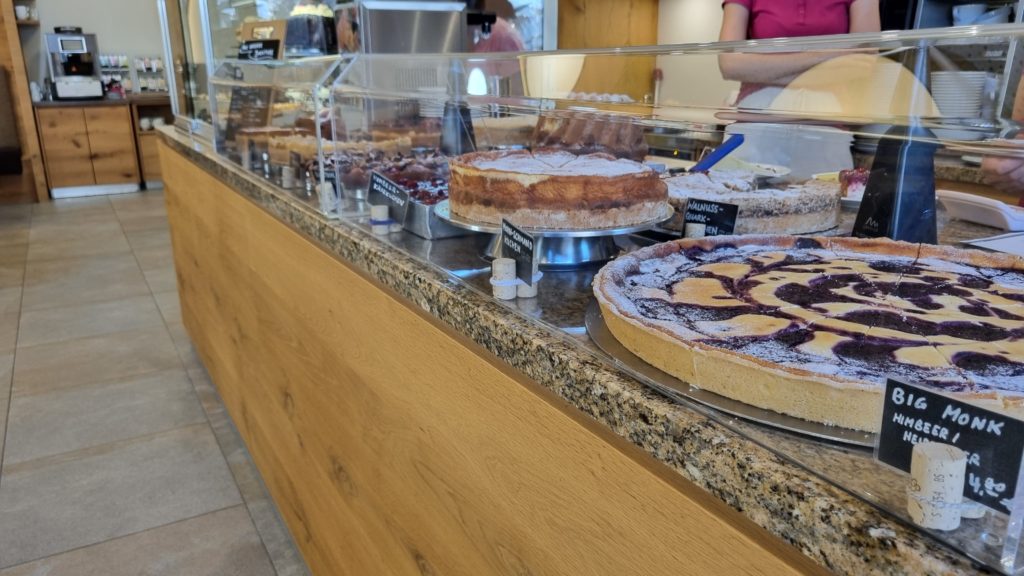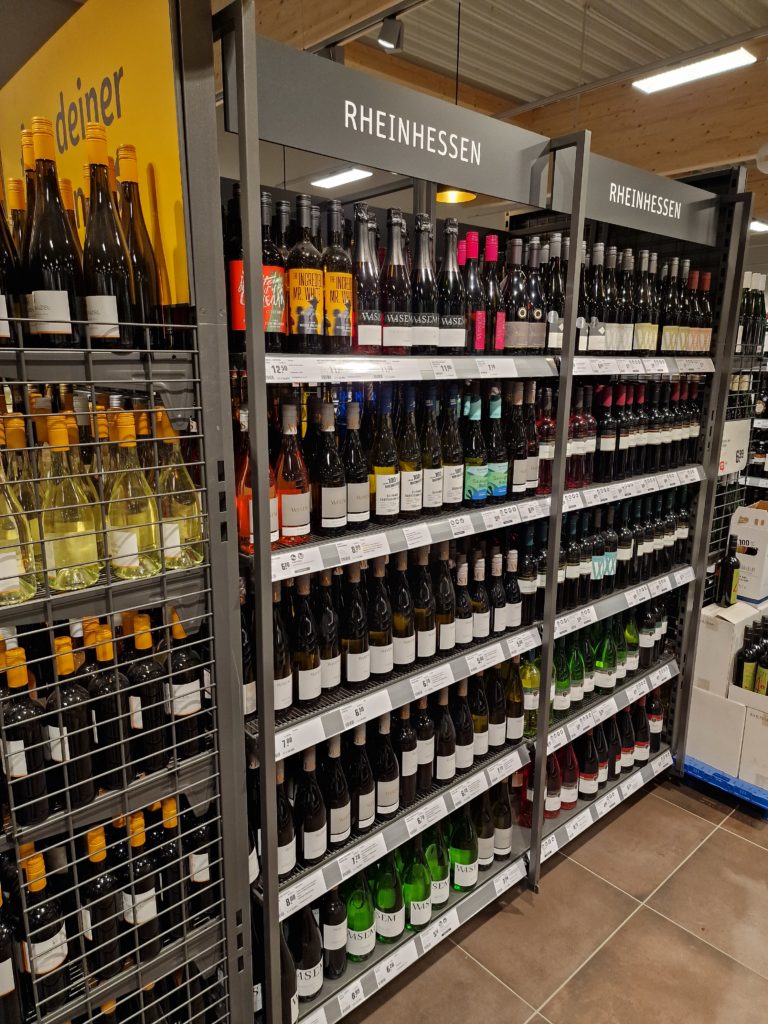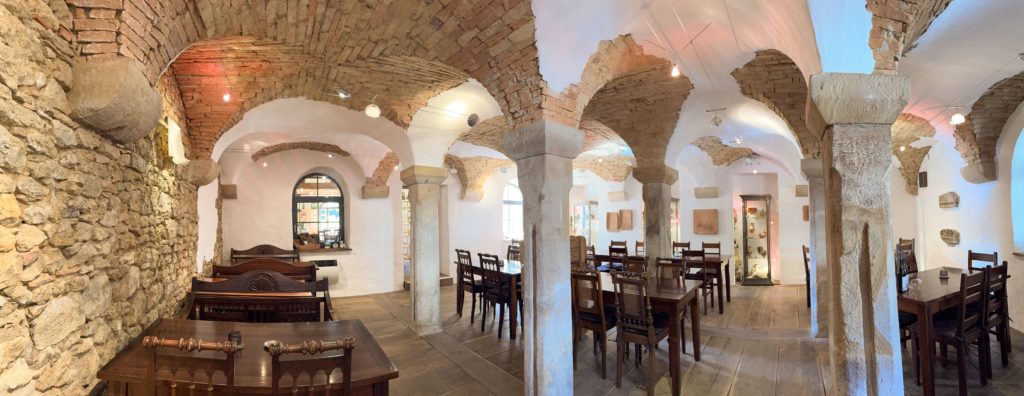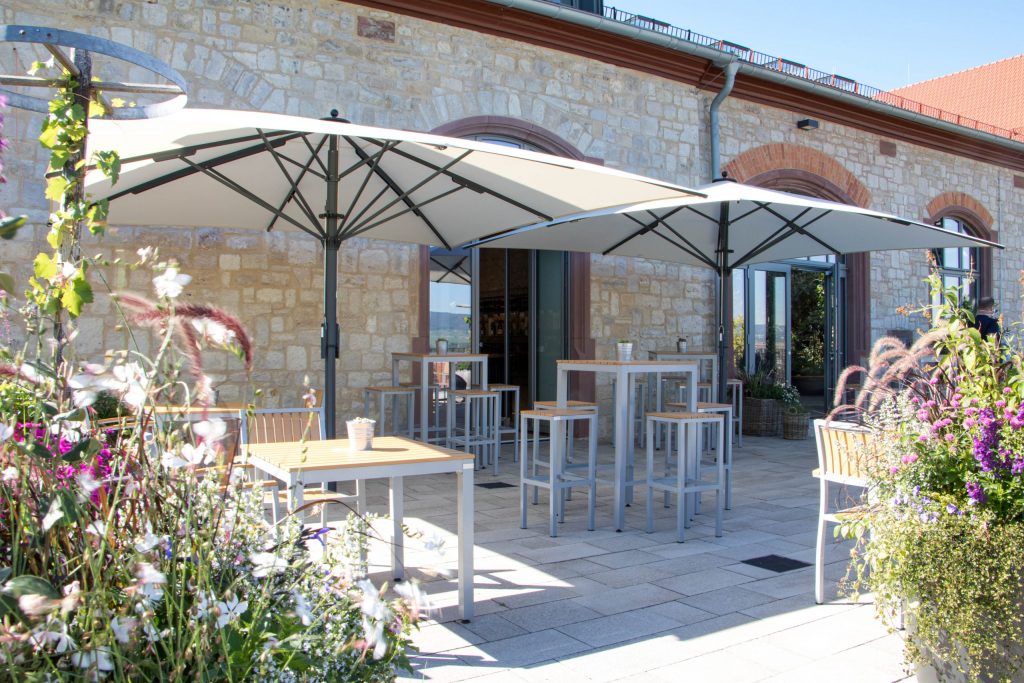
The buildings of some vinotheques impress additionally by their architecture or can tell a special story. I visited three of these vinotheques on my trip and let myself fall under their spell.
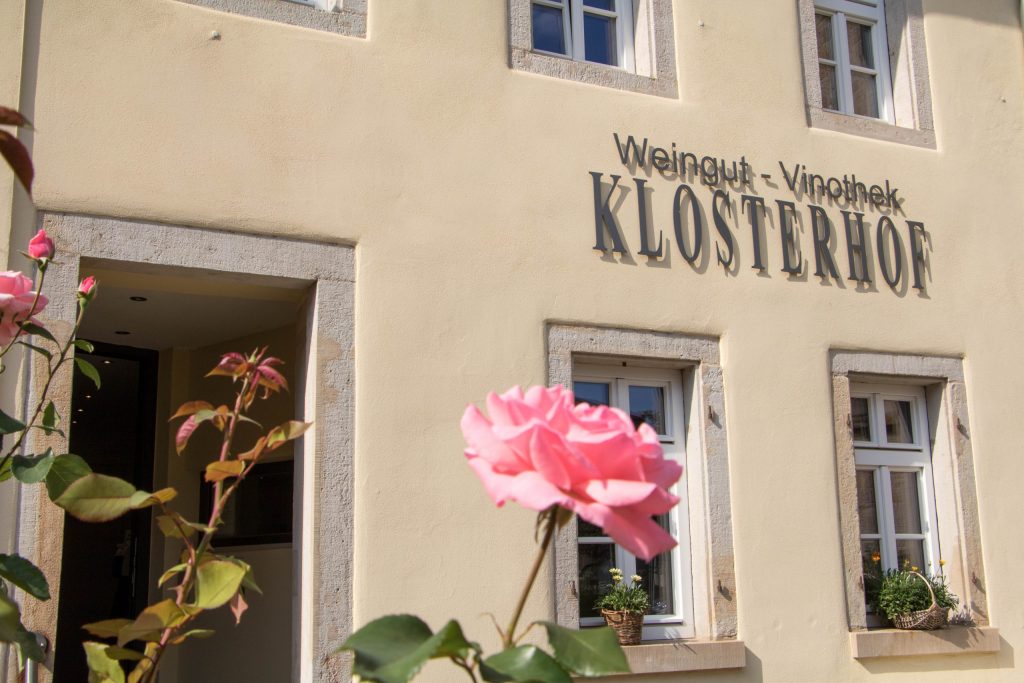
Vinotheque Klosterhof: New house in old walls
In the middle of Flonheim's market square, behind roses and a historic fountain, stands a narrow, handsomely restored structure. This houses the first destination on my journey, the Vinothek Klosterhof.

Before I step through the modern entrance door, I take advantage of the small window in the entrance area and the opportunity to "peek". Only when I enter, I realize how large and spacious this vinotheque is. I with Anke Schäfer-Graß, the friendly soul of the house, and her husband and her husband Dr. Ralf Schäfer, the winemaker.
We take a seat at a table in the cozy courtyard. While we enjoy our grape juice spritzer and the view of the "silent neighbor," the beautiful sandstone church, the two tell me about the history of this historic house.
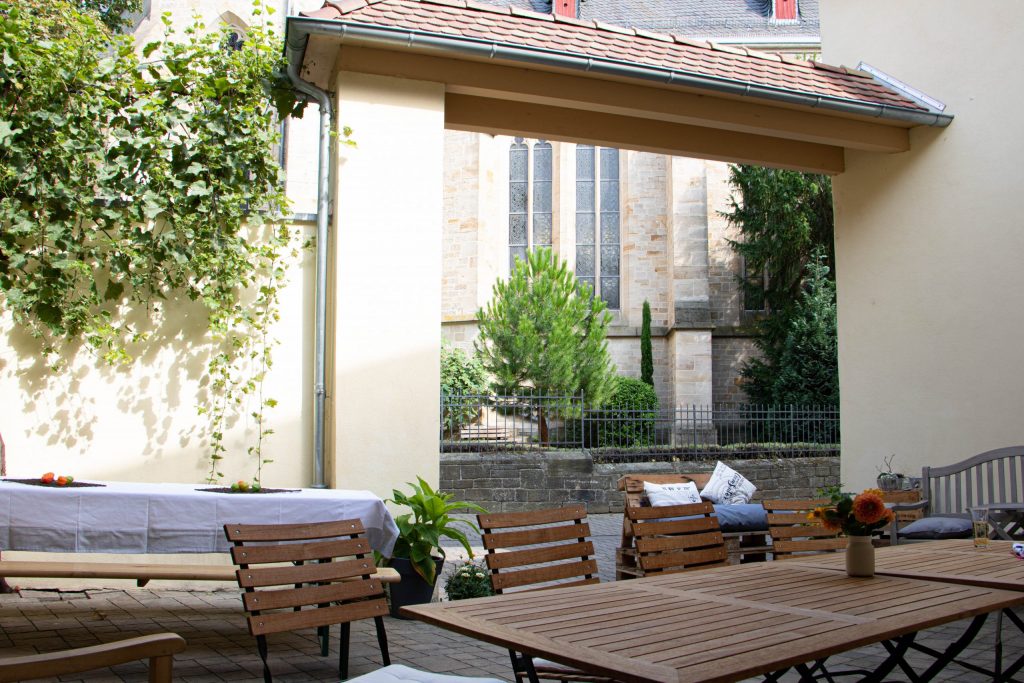
The building of the wine shop was built around the 18th century. Before being converted into a vinotheque from 2011 to 2013, these walls have already housed farms, families and an electrical market. In the times of the Leinreiter, this house was probably a blacksmith's shop that supplied the hooves of the Leinreiter horses during their stops, but we are not quite sure. The ground on which we are standing has even more stories to tell. In the Middle Ages, there was an Augustinian canons' monastery in this part of Flonheim. This has been proven by old finds. This piece of Flonheim history gave rise to the name of the Klosterhof winery.
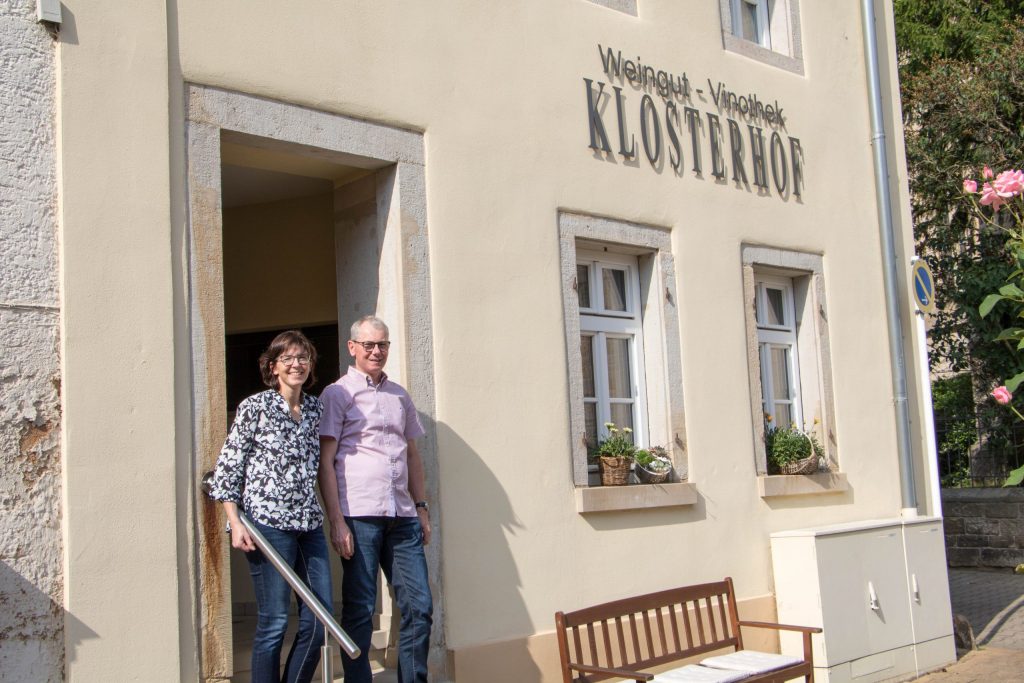
The centuries of history is the reason why the walls of this wine bar are listed. From the outside, the building was only restored to give it new splendor. A new house was created within old walls. For the new house inside, the couple has changed quite a bit, and that's what I want to look at now. I am amazed when we reach the second floor together via the wooden staircase with glass elements. Not only because of the unobstructed view to the second floor, which resembles a gallery, does this room seem large and spacious. Many guests can be seated here at the modern real wood tables.

The couple tells me that they have implemented the complete design without an architect only with the help of a structural engineer and regional and local craftsmen. This house is a community project. It contains the creativity and the lifeblood of many, I can see that. It does not need many additional decorative elements at all. The old rooms with new charm have a radiance all their own.
When you can visit the new house in old walls and what events are coming up, you can find out on the Website of the winery Klosterhof.
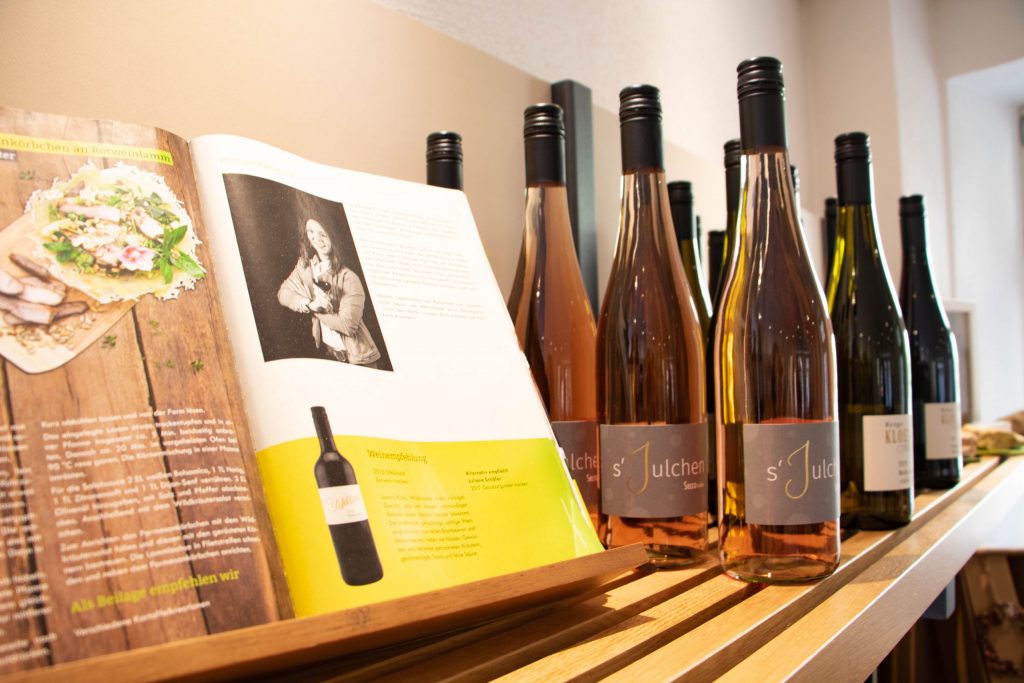
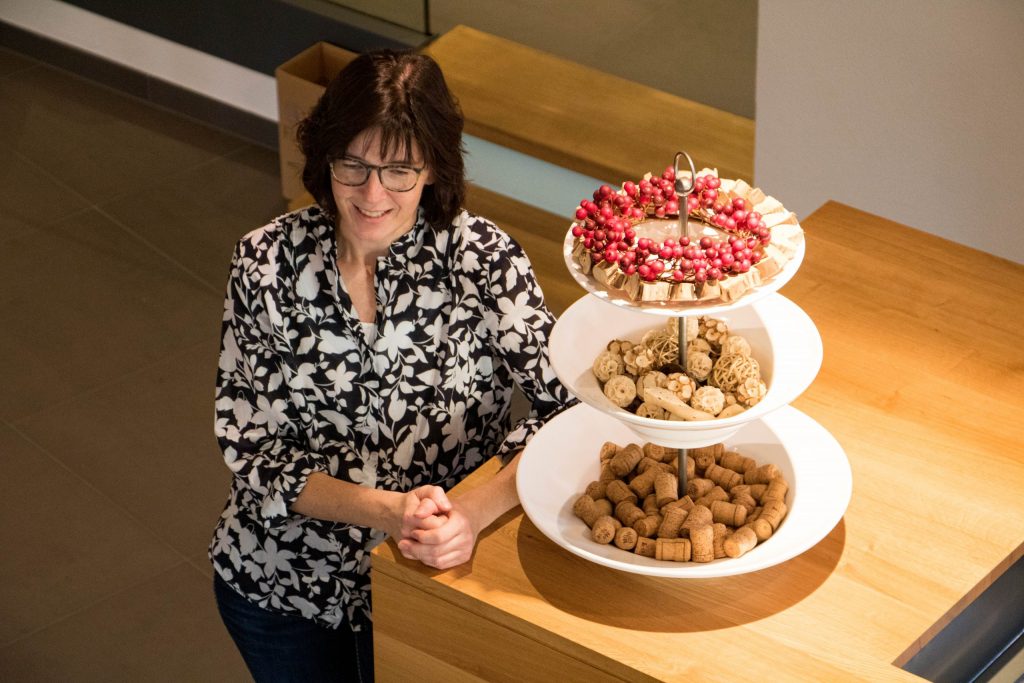
Hemmes Winery: "You can't recreate history".
I drive on to Bingen and am very excited to see what awaits me, because now it's off to school. More precisely, to the old village school in Bingen-Kempten, which is now the Vinothek of the Hemmes Winery houses. The building from 1908 impresses with simple Art Nouveau style, sandstone-framed windows, imposing entrance door and climbing vine.
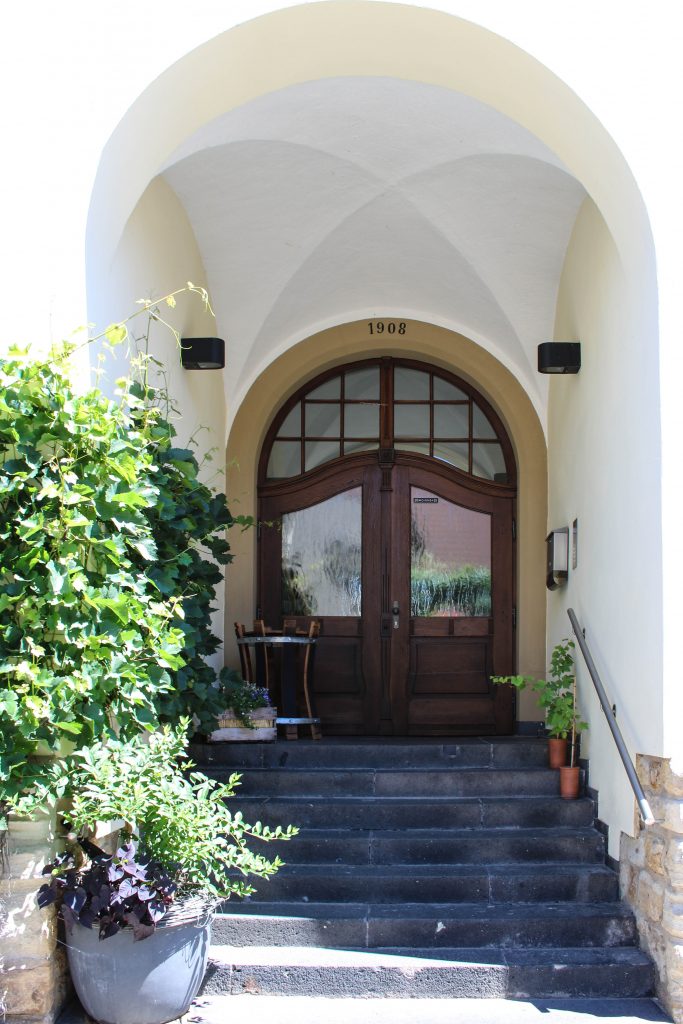
Winemaker Frank Hemmes greets me at the big door and tells me that in the past it was only allowed to be used by teachers. The students - his father was one of them - had to gather in the schoolyard and enter the building through the back door. So Friedel Hemmes had a school walk of no less than twenty seconds instead of ten, because the family's vineyard is directly opposite the school building.
In the course of the school reform of 1961, the village school was closed. Many years passed before Frank Hemmes was able to purchase and revive the listed house, but he never gave up: "This old building, this history - you can't recreate something like this anywhere in the country. In 2010, the Hemmes family received the Great Wine Capitals' "Sustainability in Wine Tourism" award for preserving the old building fabric and converting to a sustainable energy supply.

Frank Hemmes has set up his vinotheque in two of the four former classrooms. Lovingly curated objects such as an old bell, leather school bags and small writing boards recall the building's historical past. In addition, he has personally dedicated himself to the educational mission around regional wine culture.

The winegrower guides the students through his wine tasting session like a teacher in the old days, dressed in a tailcoat, top hat and cane, distributes liquid teaching aids and suitable snacks, tells interesting stories from the subjects of biology, geology and history, and always makes exciting connections with wine. This makes school fun and anything but "dry"!
Ingelheimer Winzerkeller: Modernity meets Ingelheim history
I can already see from the outside that the next vinotheque is a historic building. In front of me lies the Ingelheim Winery, a large sandstone building with red brick elements. Upon entering, I immediately feel like I'm on vacation. I am standing in a large, Mediterranean-planted interior garden. It's hard to believe that just a few years ago these walls housed a wine press hall.
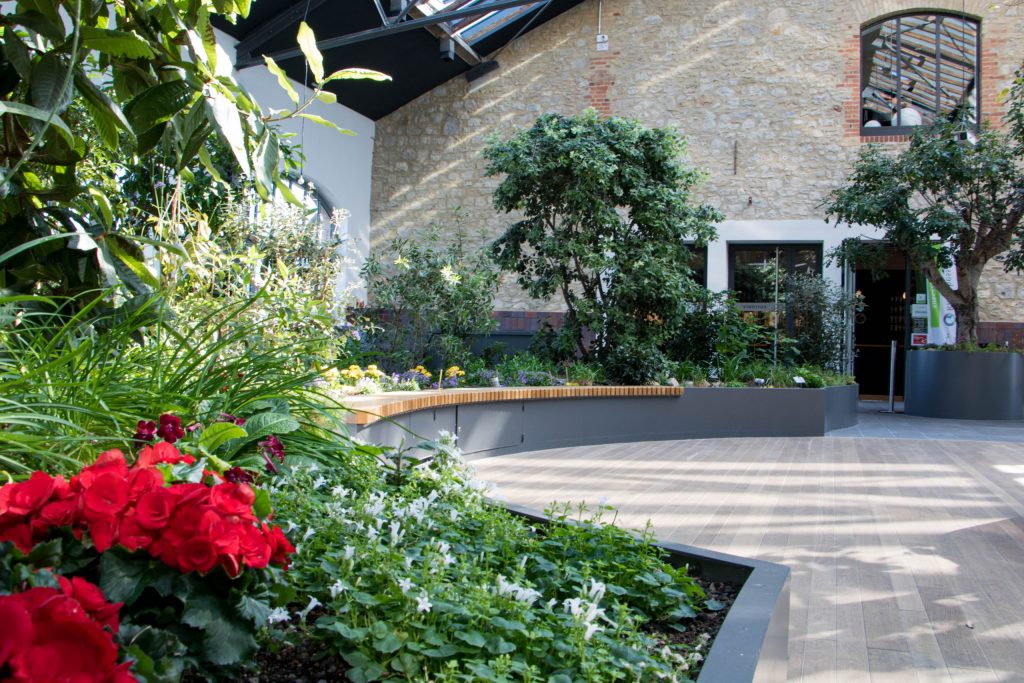
I have an appointment with Katharina Ferch, an employee of the Winzerkeller. You won't meet the vintner himself in this vinotheque, because the Ingelheim Winzerkeller building houses the tourist information office, a restaurant and a local vinotheque, which currently offers wines from 25 Ingelheim wineries. When Ingelheim was looking for a location for a local vinotheque, no other building came into question than the Ingelheimer Winzerkeller. This is what Katharina Ferch tells me. There is probably no other building whose walls tell more wine history and connect the people of Ingelheim more with their past.
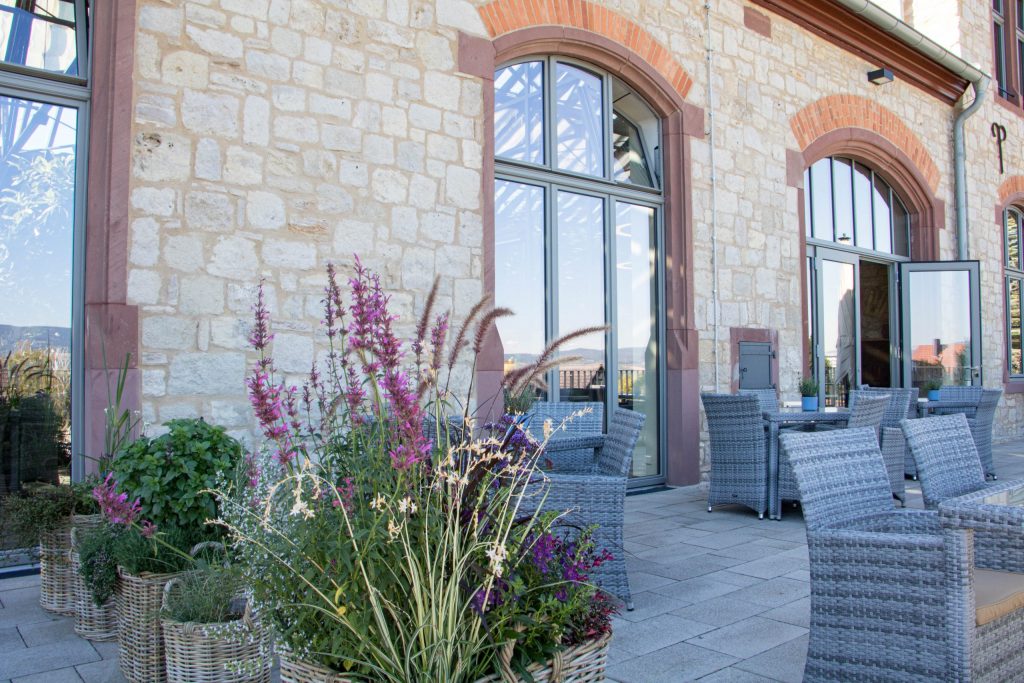
As a community cellar, the Winzerkeller was built by members of the Ingelheim winegrowers' community themselves. To help me better understand the history of the Winzerkeller, Mrs. Ferch shows me the first of the two cellars. We enter an atmospherically lit vaulted cellar. The sandstone walls were sandblasted during renovation, so they shine today in the same splendor as they did over a hundred years ago.
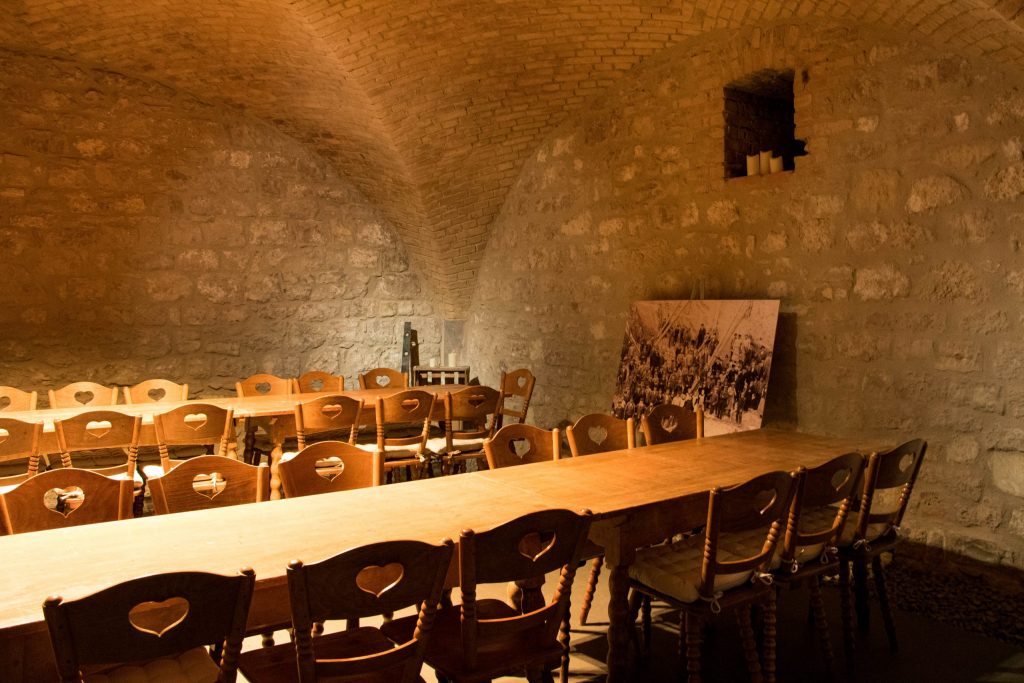
Where today there is space for events and cultural events, the wine of the Ingelheim winegrowers' community is said to have been produced until the end of the 1990s. What that might have looked like becomes clearer in the second cellar. Here, the sandstone walls still bear the original patina. This vaulted cellar is much colder and I imagine I can still smell the wine. No wonder, here old concrete tanks and a collection of wooden barrels with year-specific carvings can be marveled at.
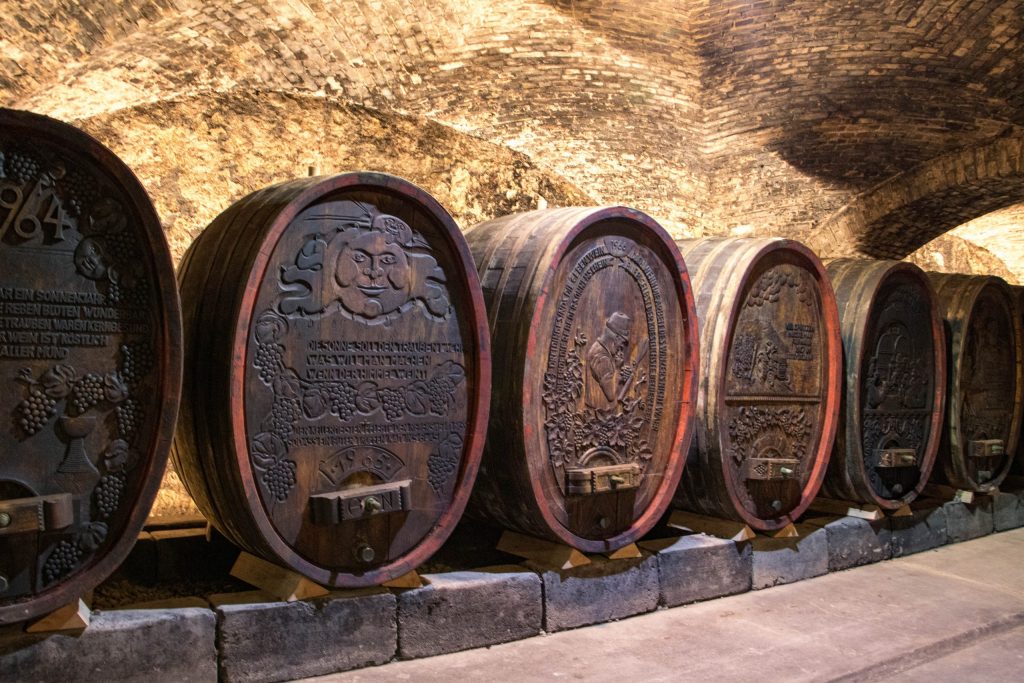
There are also said to have been wooden wine barrels that have left their mark over the years on the steps leading up. A brand new metal spiral staircase, which was milled into the sandstone ceiling in a circular pattern during the renovation, takes us back from history to the present and into the local vinotheque. I am overwhelmed by the large selection and the various labels of the 25 wineries. Two nice employees are already waiting for me and so I am, as usual in a vinotheque, well advised in the wine selection.
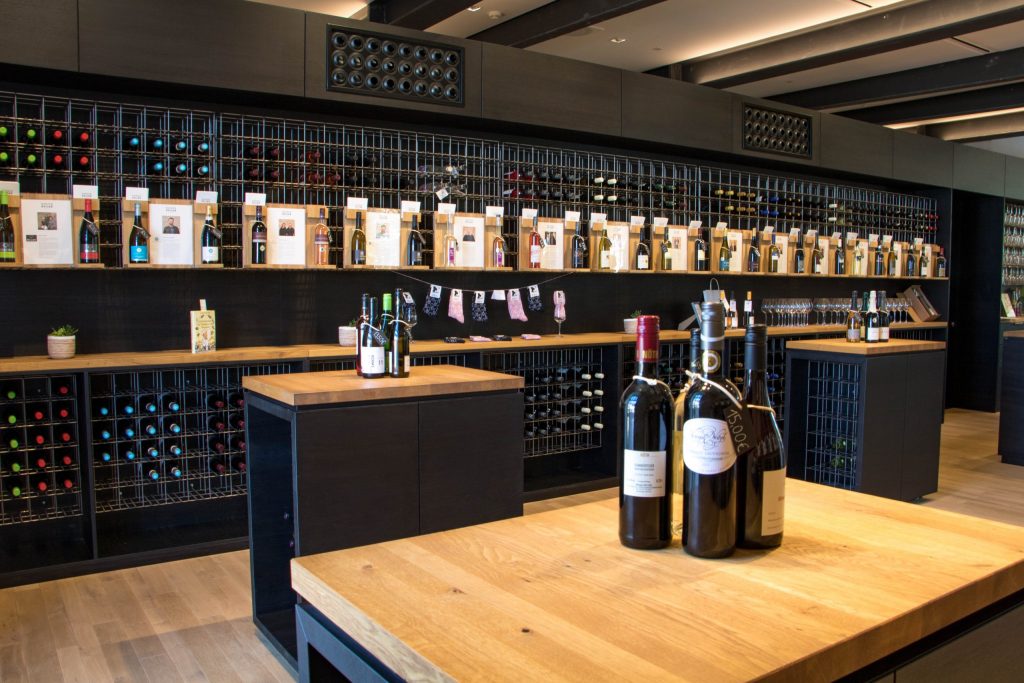
I can make myself comfortable outside on the terrace and enjoy the view over the small table grape vineyard of the Winzerkeller across to the other side of the Rhine. At the same time, I try my way through Ingelheim's diverse range of wines.
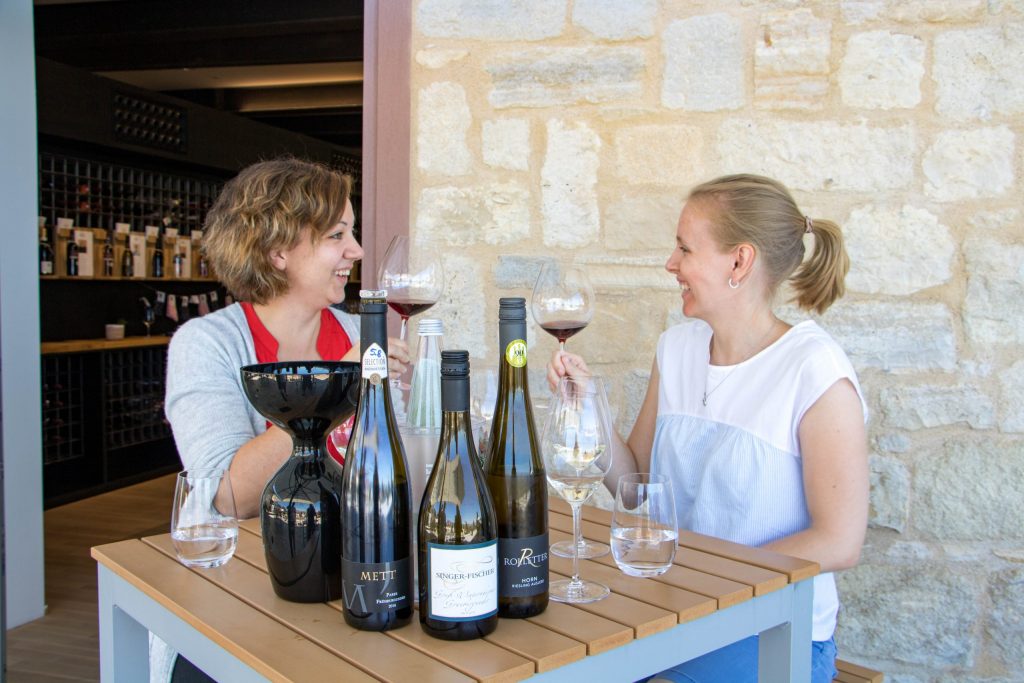
On the website of the Ingelheimer Winzerkeller you can get more information about the Ingelheim local wine cellar and the opening hours.
Even more vinotheques
Currently there are 30 of these special vinotheques - and the network is growing. You can get an always up-to-date overview of all Rheinhessen-AUSGEZEICHNET vinotheques here.

